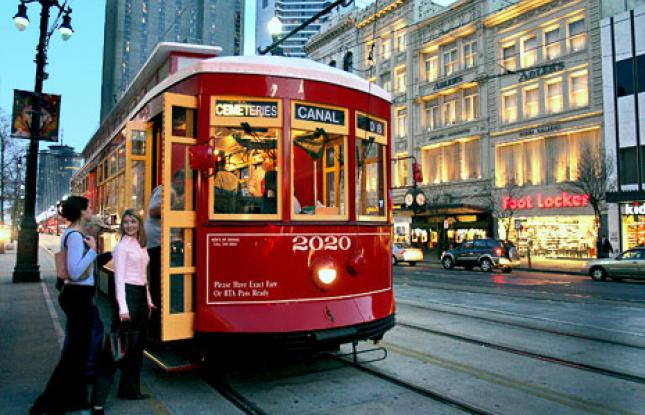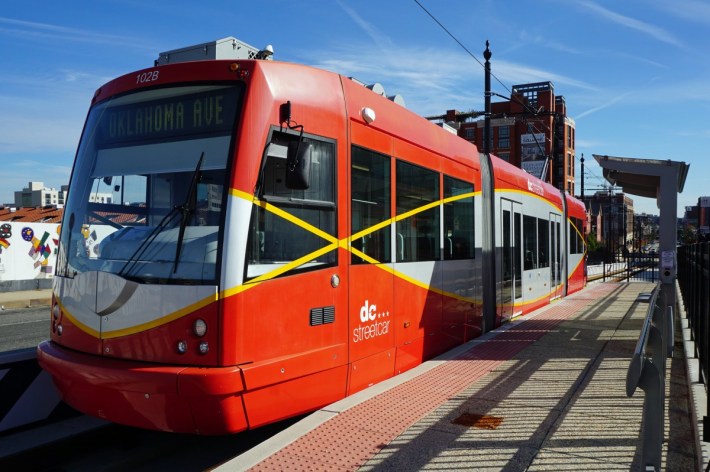"Colorblind" transit projects such as the modern American streetcar can perpetuate structural racism as much as highway projects built around the needs of white motorists, a new study argues.
In a study in the Journal of Race, Ethnicity and the City, researchers Anna Livia Brand, Kate Lowe and Em Hall dove into the history of H Street Streetcar in Washington, D.C., and the Rampart Streetcar in New Orleans, La. — two of many, many 21st century streetcar projects that local officials lauded as path-breaking transit investments in Black and brown communities, but that didn't benefit residents. In both cases, the researchers found many residents who viewed the streetcars as a plaything for rich white folks — and ample evidence that they weren't designed with low income people of color in mind.
"Proponents present streetcars as innocuous infrastructure strategies to attract investment in areas that had previously seen decades of disinvestment," the researchers wrote. "Yet as one interviewee noted, these streetcars are examples of an 'expensive frill for the White folks' that facilitates recreation and [capital] accumulation while failing to address transport needs of low and moderate income Black residents."
When tourist kitsch trumps local mobility
In both cities, local developers and politicians rallied behind the streetcars as a way to super-charge economic development from outside interests, rather than as a real mobility option for residents — and they didn't exactly try to hide it.
New Orleans sold locals on the Rampart Streetcar as a key to the region's economic recovery after Hurricane Katrina, which knocked out half of the city's bus routes. But locals began to question whose mobility was the priority — because the trolley route was located on a road between the tourist-focused French Quarter and the historically Black neighborhood of the Treme, which already had a functioning bus route.
"In a city where the Black community bore the brunt of the impacts from the hurricane, and there were such huge issues around housing affordability and right to return, all this funding pouring into new streetcar systems in New Orleans was really troubling," said study co-author Dr. Anna Livia Brand, a professor of environmental planning at UC Berkeley.

Many New Orleanians the researchers interviewed felt that the streetcar served the mostly white visitors to the city, who tend to view buses as dirty and unglamorous. And residents also resented that $45 million in scarce federal grants were spent on a project that provided tourists with a kitschy trolley ride, rather than repairing the city's battered transportation infrastructure.
"I think white tourism and nostalgia [for the streetcar era of the earliest 20th century] is really critical to many of these projects," said Brand. "Because it’s often about creating spaces where white tourists can consume — spaces that both rely upon and sanitize Blackness."

Washington's H Street Streetcar also unnecessarily duplicated a commuter bus route through a historically Black neighborhood, but the city raised even more hackles when it announced the trolley would be fare-free. That was great news for the mostly white business owners along the commercial corridor next to the trolley line — a group that had helped attract a wave of rich, mostly white residents who almost doubled the area's median household income from 2000 to 2015, turning Black residents into a minority in the neighborhood for the first time in decades. But it didn't seem fair for the low-income workers along H Street who still had to pay to take the X2 bus line, which runs along the same road, far past the trolley's two-mile service area.
"The proper answer is the residents in the H Street and Benning Road corridor [are the target riders]," said an anonymous interviewee cited in the study. "The more descriptive, personal answer . . . it’s for the gentrifiers who have moved to the H Street corridor; people who don’t like to ride the bus and think buses are only for the poor folks and they don’t want to mix with the poor folks, so they’d rather have their streetcar."
Like the New Orleans trolley, the District's streetcar carried a hefty price tag: $200 million. Even worse, the project relied on scarce local funds — and local dollars are some of the only money for crucial but less "sexy" transit enhancements, such as improving bus service.
"Unfortunately, federal transit dollars are actually restricted to capital projects in metro areas over 200,000 residents," said Dr. Kate Lowe, a professor of urban planning and policy at University of Illinois, Chicago, and another of the study's co-authors. "But even beyond that incentive, there’s a big political appeal to building something new, rather than enhancing service on transit you've already got...[The H Street Streetcar] is a reminder that, even when federal restrictions really encourage investment in capital projects, there are still these powerful local players who will push for every possible local dollar to be spent on capital projects, too."
Whether the H Street investment paid off for D.C.'s BIPOC residents is unknown: Tthe local transportation department doesn't collect demographic information on the streetcar's riders. On the parallel bus route, though, the stats are clear: 81 percent of Washington Area Metro bus riders are Black or brown, and the service they pay for is so unreliable and slow that it's hurting the local economy.
How to build antiracist transit
Of course, a streetcar isn't inherently a racist transportation mode. But because they often cost so much, cover such small areas, and carry heavy associations with racist movies from the 1940s, progressive urbanists tend to see trolleys more as glorified theme park rides than as meaningful transit. And they also don't do much to combat car dependency, cut congestion, or even improve roadway travel speeds.
"At least right now, streetcars are predominantly being implemented in the shared travel lane, and without a dedicated right of way, there’s no speed advantage to them," Lowe reminds. "We have to reckon with our current car-dependent systems, but I also think it’s really important to take a look at which transit investments are being made, and whether they actually benefit Black and brown riders."
Both Lowe and Brand are cautiously optimistic that transportation advocates have begun to understand the importance of centering the needs of historically oppressed groups in our planning processes, especially in the wake of the George Floyd uprisings and US cities' COVID-19 equity failures. They're also hopeful that by putting mobility justice first, we might put "colorblind" streetcar projects like H Street and Rampart behind us — and start building transit systems that meet communities' needs.
"When you think about someone who needs to get her kids to school in the morning and then get to work, if the local transit network doesn’t line up with her needs, some researchers say the most just thing to do is just to give her a car," said Brand. "I’m not advocating for car dependency. But we have to acknowledge that we have these very different transportation needs across our society, and we need systems that start to attend to those kinds of complexities. I don’t know that we know how to do that, yet; it’s going to take a lot of deep commitment to transforming the ways that we live together in our urban systems and how white supremacy is inscribed in our landscapes. But the goal, at the end of the day, is not to have racism so deeply inscribed into tour public transit system. How to get there is what we’re asking now."






